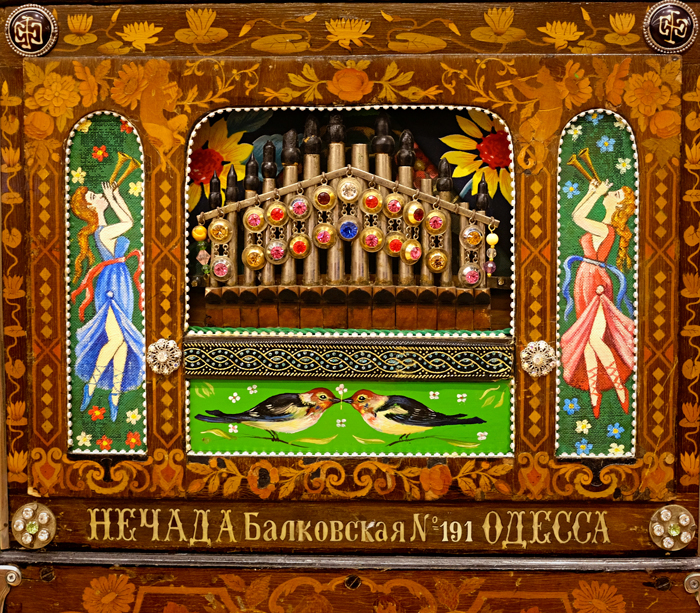Hole in the Clouds
Nov 16, 2009

An apartment building in Prypiat, the Ukrainian town built for the families of people who worked at the Chernobyl nuclear power plant. Two days after the nuclear accident in 1986, Prypiat was abandoned.
After twenty-three years, radiation levels have dropped significantly here, but no one is yet permitted to live anywhere in the Exclusion Zone surrounding Chernobyl. It is not considered especially dangerous to spend a few hours visiting the area, however, and a local tourism industry has emerged.
This is a High Dynamic Range photo by Trey Ratcliffe. The Hong Kong picture in the November 4 Good Morning was also by Ratcliffe.
high dynamic range
Chernobyl
Prypiat
Ukraine
(Image credit: Trey Ratcliffe)
Nov 22, 2009

Olha Pryymak is a Ukrainian-born artist who lives and works in London. When she's feeling nostalgic or homesick for Kiev, she paints a caviar sandwich with a glass of tea.
food
art
Ukraine
Olha Pryymak
Kiev
(Image credit: Olha Pryymak)
Jan 15, 2013
 The Russian painter Ivan Shishkin was illustrating scenery in Poland in 1890, when he completed this painting of the swampy forests of the Pripyat, or Rokitno, marshland. Today, the spot where he set up his easel could be in Ukraine or Belarus or Russia or perhaps extreme eastern Poland.
The Russian painter Ivan Shishkin was illustrating scenery in Poland in 1890, when he completed this painting of the swampy forests of the Pripyat, or Rokitno, marshland. Today, the spot where he set up his easel could be in Ukraine or Belarus or Russia or perhaps extreme eastern Poland.
But the scene he painted may or may not look much the same. The marshes of Polessia remained lightly settled throughout much of the twentieth century; the forests there provided years of cover for partisans fighting for and against the Nazis and the Soviets.
Then came the Chernobyl nuclear disaster of 1986, which devastated much of the countryside, leaving large stretches radioactive and uninhabitable. Not all the wildlife has returned. Although herons have again been reported, "mushrooms and berries," it is said, "set Geiger counters screaming."
landscape
Russia
Belarus
Ukraine
birds
1890
Poland
great blue heron
Russian painting
marshland
Pripyat Marsh
(Art by Ivan Shishkin)
Jan 24, 2015
 This is the front panel of a Nechada barrel organ, made in Odessa, Ukraine, in the early years of the twentieth century. It was often set up in the street outside a bar or brothel, in hopes that the popular tunes it blasted out would draw a crowd of potential customers. Sometimes, of course, the organ grinder had a monkey as an added attraction, or a troupe of very young girls, perhaps eight or ten years old, who danced and sang and turned cartwheels to entertain the drunks.
This is the front panel of a Nechada barrel organ, made in Odessa, Ukraine, in the early years of the twentieth century. It was often set up in the street outside a bar or brothel, in hopes that the popular tunes it blasted out would draw a crowd of potential customers. Sometimes, of course, the organ grinder had a monkey as an added attraction, or a troupe of very young girls, perhaps eight or ten years old, who danced and sang and turned cartwheels to entertain the drunks.
Odessa was home to a number of piano manufacturers, who made these organs as a sideline. No musical skill was required to operate them; the organ grinder just turned the crank on one side of the box, which pumped air through the organ pipes and also spun rolls of paper that had been pre-programmed with the desired musical compositions. The paper blocked air from entering the pipes except where holes had been punched; when a hole in the paper came in line with the opening to a pipe of the desired pitch, air was forced through the pipe, generating each note of a song.
Odessa street organs, called sharmankas, were sold throughout the Russian empire from about 1860 until they began to be replaced by more modern music machines, notably record players, in the 1920s. Even then, they remained in use by street buskers, particularly in Tbilisi and other Georgian cities, where street organs were popular well into the 1960s.
The inscription across the bottom of this organ gives the name and address of its maker. Ivan Viktorovich Nechada worked out of a piano factory on Balskovskaya Street, now Isaac Babel Street, in Odessa. This organ is in the collection of the new Musical Instrument Museum in Phoenix, Arizona, but recently a very similar Nechada organ, said to be in perfect working order, was advertised in Moscow; "May be sold or exchanged for a car," wrote the seller, in an ad in Mechanical Music Digest.
music
Ukraine
Odessa
Musical Instrument Museum
Arizona
mechanical organ
Phoenix
organ
(Image credit: Fuji T)



